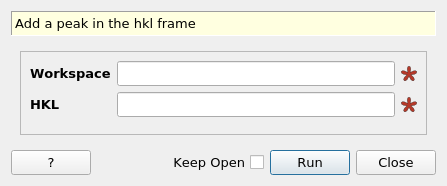\(\renewcommand\AA{\unicode{x212B}}\)
AddPeakHKL v1¶

AddPeakHKL dialog.¶
Summary¶
Add a peak in the hkl frame
See Also¶
Properties¶
Name |
Direction |
Type |
Default |
Description |
|---|---|---|---|---|
Workspace |
InOut |
IPeaksWorkspace |
Mandatory |
An input workspace. |
HKL |
Input |
dbl list |
Mandatory |
HKL point to add |
Description¶
Add a peak in the HKL frame to an existing PeaksWorkspace. The OrientedLattice must be provided and the Goniometer should be set correctly before running the algorithm.
The peak is added to the existing PeaksWorkspace. Run information and goniometer setting and the UB matrix are taken from the provided PeaksWorkspace.
Usage¶
Example - AddPeakHKL
import os
import numpy
import mantid.kernel
# Create an instrument workspace
inst_dir = config.getInstrumentDirectory()
sxd_ws = LoadEmptyInstrument(os.path.join(inst_dir, "SXD_Definition.xml"))
AddSampleLog(sxd_ws, 'run_number', '1', 'Number')
# Create a peaks workspace from the instrument workspace
peak_ws = CreatePeaksWorkspace(InstrumentWorkspace=sxd_ws, NumberOfPeaks=0)
peak_ws.mutableRun().addProperty('run_number', sxd_ws.run().getProperty('run_number'), True)
# Apply a UB
ub = numpy.array([[-0.15097235, 0.09164432, 0.00519473], [ 0.0831895, 0.14123681, -0.06719047], [-0.03845029, -0.05534039, -0.1633801 ]])
SetUB(peak_ws, UB=ub)
# Add a new peak
AddPeakHKL(peak_ws, [2, 0, -4])
# Get info on newly added peak
peak = peak_ws.row(0)
print('Peak wavelength {}'.format(round(peak['Wavelength'], 4)))
print('Peak detector id {}'.format(peak['DetID']))
print('Peak run number {}'.format(peak['RunNumber']))
print('Peak HKL [{},{},{}]'.format(int(peak['h']), int(peak['k']), int(peak['l'])))
Output:
Peak wavelength 1.8423
Peak detector id 25766
Peak run number 1
Peak HKL [2,0,-4]
Categories: AlgorithmIndex | Crystal\Peaks
Source¶
C++ header: AddPeakHKL.h
C++ source: AddPeakHKL.cpp
